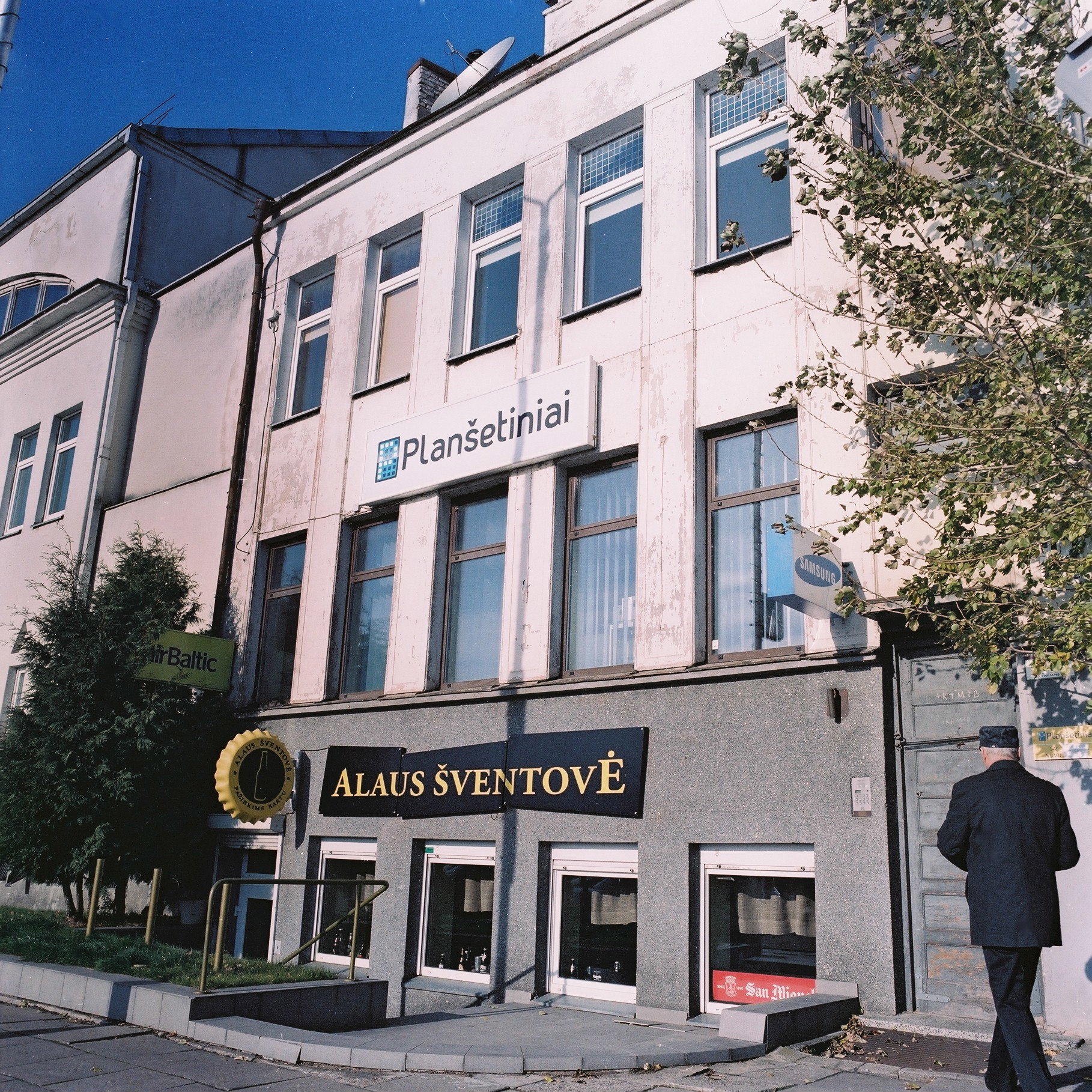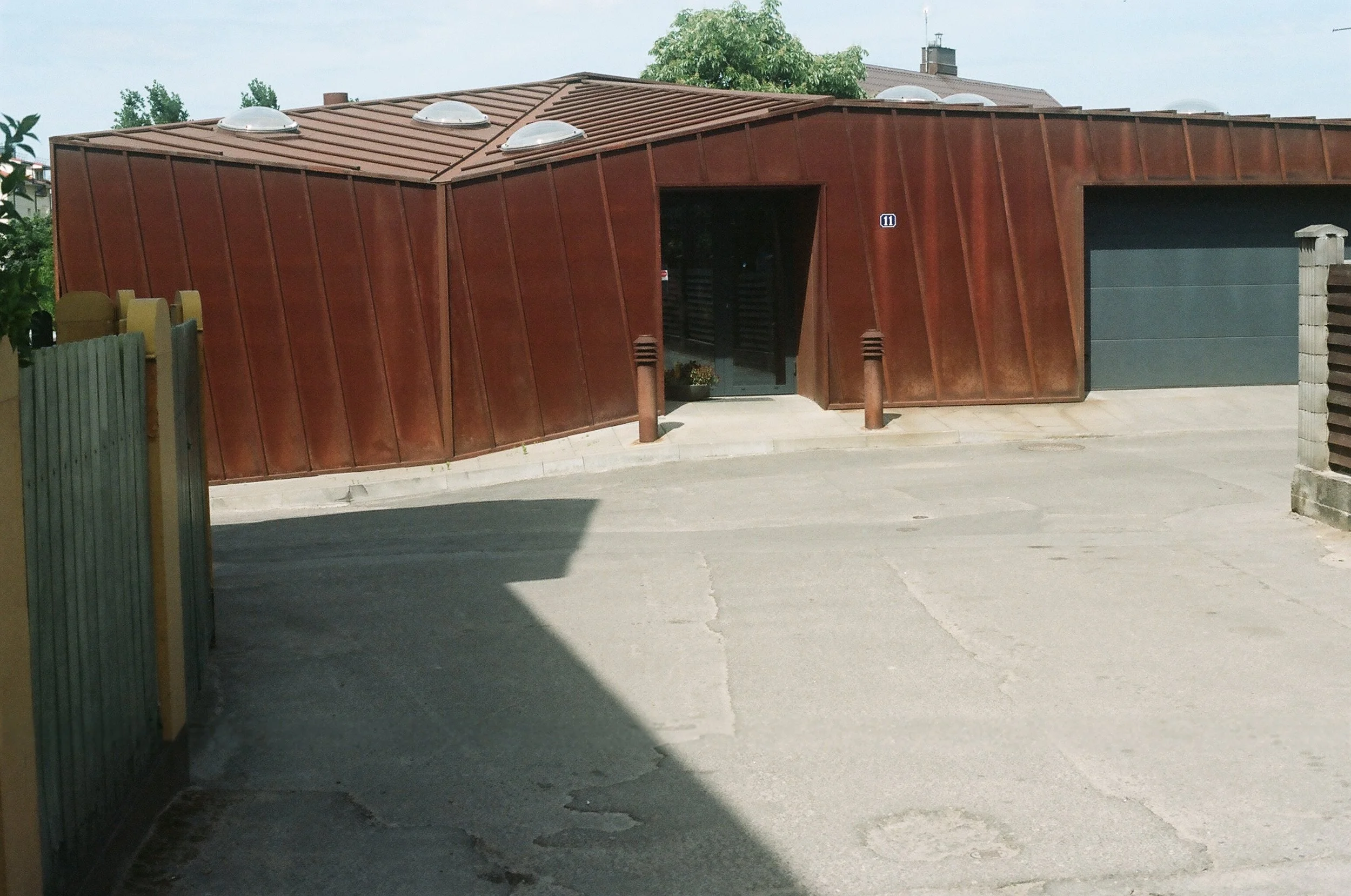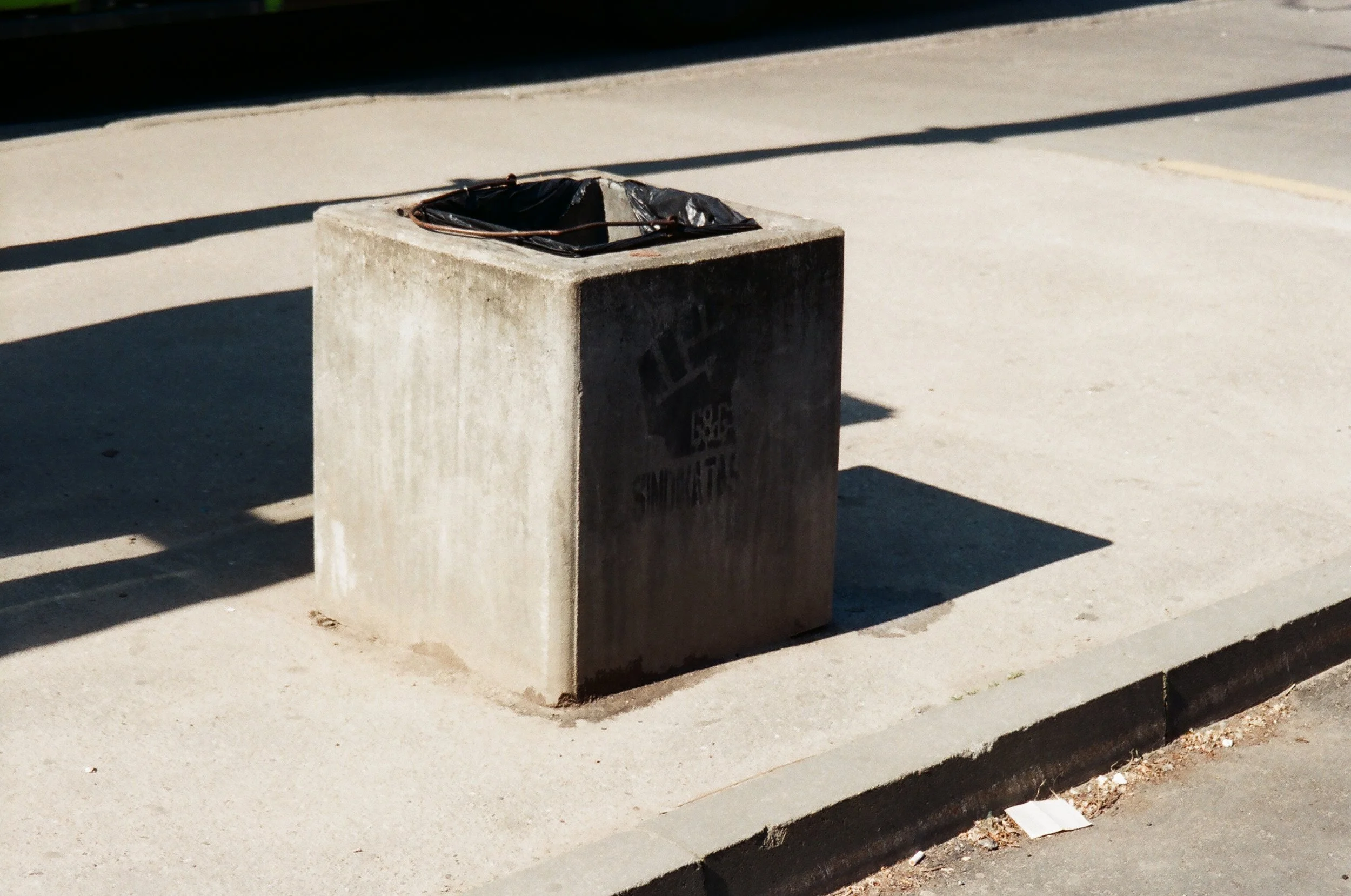The gates of a town (the store advertising on main street of a town).
There were two photo exhibitions in Kaunas Vytautas Magnus university Gallery 101. All photographs were taken on colour negative film, mainly Kodak Portra and Kodak Pro Foto.
Cameras used to make these photographs were: Contax RX, lens Planar 50/1.4; Olympus mju II 35mm, Pentacon Six TL
The history on the historic wall (short text about town history in the courtyard of the Presidency, Kaunas was capital of Lithuania before WWII ).
The photos displayed in the exhibition “54°53’50” N, 23°53’10” E Niekieno miestas – Nobody’s Town“ were inspired by the images of the pre-war Kaunas in the photographs of Mečys Brazaitis, who was brilliant in rendering the vision of a developing European town. The images correspond to the reminiscences of Marcelijus Martinaitis. In his book “Mes gyvenome. Biografiniai užrašai“ 2009 (We Lived. Biographical Notes), M. Martinaitis describes: “…Hard and tedious as the work had been, people’s financial situation improved, and the last years of Lithuanian independence remain in my memory as very bright. (At our house) there were quite a few purchased items: clothes, beautiful little boxes, and tools (I used to play with my father’s cap, the inner side of which had some picture of an artist or singer, possibly Kipras Petrauskas himself), Žuvelis soap of very pleasant fragrance; I used to be captivated by a beautiful leather purse of my mother, who, coming back from town, would take out a sweet or a bun from it. When she was unaware, I would open the purse and inhale the scent of sweets, buns, perfume or money. (…) I have been thinking about how close to Europe we had been then, and how all these little pleasant things disappeared with either their owners’ death or the oppression of bolsheviks. “
Marcelijus Martinaitis was distressed and appalled by the fact that in the post-war years, people were deprived of the ability to pass family stories and traditions to their offspring.
The human metamorphosis (the first president of Lithuania Antanas Smetona on the picture, his sculpture and the market place named after him in these days).
The values have changed (the roof of Lithuanian bank and the roof of the bazaar).
The pre-war images of Kaunas, my parents’ and my grandparents’ stories as well as old family pictures still bring the feeling of nostalgia. The town in Mečys Brazaitis‘s photos taken 80 years ago has not undergone many changes. Nevertheless, something is missing. The majority of things disappeared for good and cannot be revived. The greatest loss the town has experienced is its inhabitants, the ones who developed the Town and lived there. Gone are the true owners of the buildings, the old inhabitants. The Town has become everyone’s and, at the same time, nobody’s.
The jail forever (jail from 1863 years for these days).
People have been replaced with a plethora of memorial plaques, which are turning the town into necropolis. The majority of the buildings marked by commemorative plaques have no traceable link to people. As for the architecture itself, it resembles some ancient theatre stage decorations that are incongruous with modern ‘show parades’, which are more compatible with glass ‘aquariums’ decorated with images of national currency. We are beating New York by the number of billboards and supermarkets. Monumental statues are proliferating in the Town; “Valančius” has been erected on a street corner, and the Pope “is on a visit” at the former stadium of “Darbo rezervų“ (labour reserves).
Neopagan (the beer bar named “Church of beer).
The stronghold (blockhouse, fort) forever (the living cottage from steel sheets).
Although the Town is situated at the confluence of two rivers, boats sail only on Sundays… Overall, everything is splendid, our geographic location of 54°53’50” N, 23°53’10” E is perfect, and the environment is shaped by mortals.
The home of the souls who left (The synagogue ruins).
The heroes of our times (a political - financial figure fleeing to Russia).
Princess Potemkin's style (Grigorij Potiomkin; 1739-1791 Catherine II's favorite, decorated the Russian villages with the arrival of a tsarina. On the photos the ruins decorated with advertising and concrete stairs to the medieval castle).
It is beyond the power of one photographer to narrate the history of a town, and I do not expect to accomplish such a task. I would like my exhibition to serve as an incentive for others to take a close look at their place, the street, the neighbourhood, the district they live in.
The photo exhibition “54°53’50” N, 23°53’10” E. Niekieno miestas – Nobody’s Town” was on display at “101Galery” in February, 2013. In April of the same year, it was presented in “Latitudė55.lt”. The same month, our discussion “A Glance at the Town – A Glance at Oneself” was published in the journal “Statyba ir architektūra” (Civil Engineering and Architecture) The decreasing population of Lithuanian towns motivated historians, architects, and anthropologists to search for town identity, study the issues of human co-existence, and to restore the Lithuanian heritage of the period between the two wars (WWI and WW2).
Wagon of Petras Vileišis (The lost a market advertisement near the Petras Vileišis Bridge. Petras Vileišis famous Lithuanian engineer).
People do not seem to be unconcerned about where and how they live. However, the impression starts to fade when you are out on the street. Presently, I wish to finish what is infinite as the stories are continued by different narrators. While the geographic coordinates of „54°53’50” N, 23°53’10” E never change, the environment itself is gradually turning into a territory without traditions or history under the code name of LEZ, which cannot be explained or decoded. A lukewarm wish to turn to the past still exists. However, enough energy is left merely for the production of memorial plaques.
Wizardy echo (on the photo advertising of newspaper“Lithuanian echo“ and Wizardy salon).
The monuments wanderers (monuments wanderers built regardless of the environment).
The elite are hiding in castles, nature reserves, and urban ‘bunkers’ of reinforced concrete. The rest are left with LEZ, a phenomenon, the development of which depends on the whims of nature or Charles Darwin’s laws of natural selection: various combinations as well as hybrid alliances are possible.
Rubliovka or 289,62Euro 9 (building was decorated with image of baknote 1000 Litas,Lithuanian currency,when Euro came it became 289,62Euro. Rubliovka - Ruble is a luxury Moscow city district).
Legends of the Harbor (Kaunas was rivers port...)
Our reality is far from the one of Disneyland. Here, next to the university edifices in the style of art deco, ‘castle-towns -Marienverderiai’, ‘houses of Oslo’ are springing up. Vytautas Kavolis’s warnings on avoiding the poverty culture have been ignored… Simply, life is on the verge of survival. The press "The Other Books" was published by the Italian theorist Giorgio Agamben, "Homo Sacer: Sovereign Power and Nude Life" (Saulius Jurga from the Italian Language; Vilnius: Other Books, 2016), which only confirms today's insights:
“Politics turned into a biopolitics, which is a concentration camp. Biopolitics is the transition from rule-based management to non-management-based management is a problem stemming from each security policy managed through leadership through administration ... Today, we can obviously see a huge increase in the entire legal system and legal regulation. At the same time, the regime as the maximum of anomy and clutter can perfectly coexist with the maximum lawmaking ... What is the camp? It is a part of the territory that exists beyond the legalization of the legal-political order, the state of exception. Today, the state of exclusion and depoliticization have tarnished everything. "
Diagnosis on the fence (Until the law is changed, the monsters will continue to defame the town – text on a poster.Monsters are brutal architectural buildings).
Market aesthetics (trash bin next to the bus stop ).
So hello, live at the LEZ camp !!!
P.S. musical track for illustration.
Connect
Film photographer Robertas Kanys is a member of the Lithuanian photographer's union. For seven years he has worked as an instructor of photography in the Vilnius Art Academy, Kaunas faculty. See more of his work here.

















